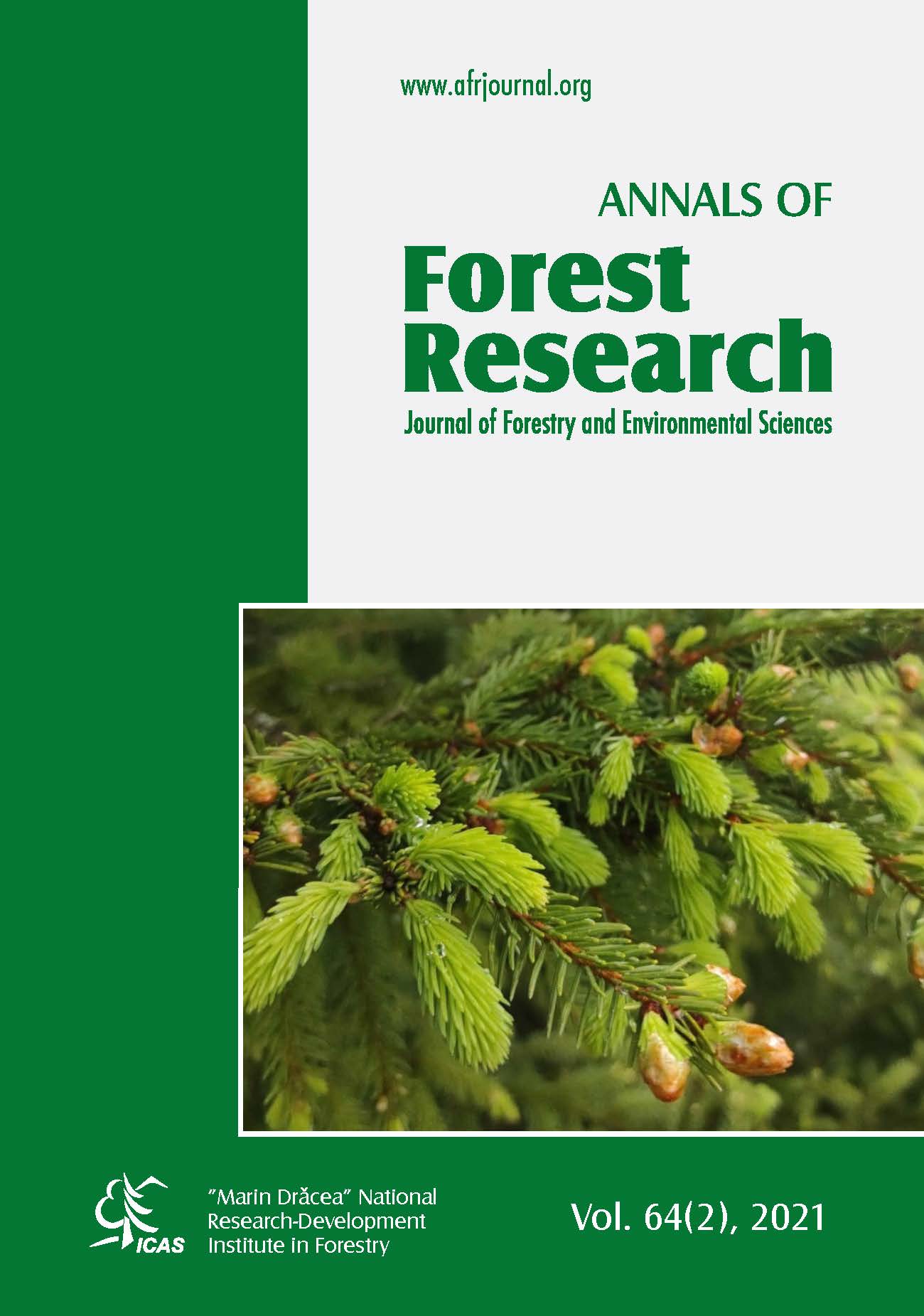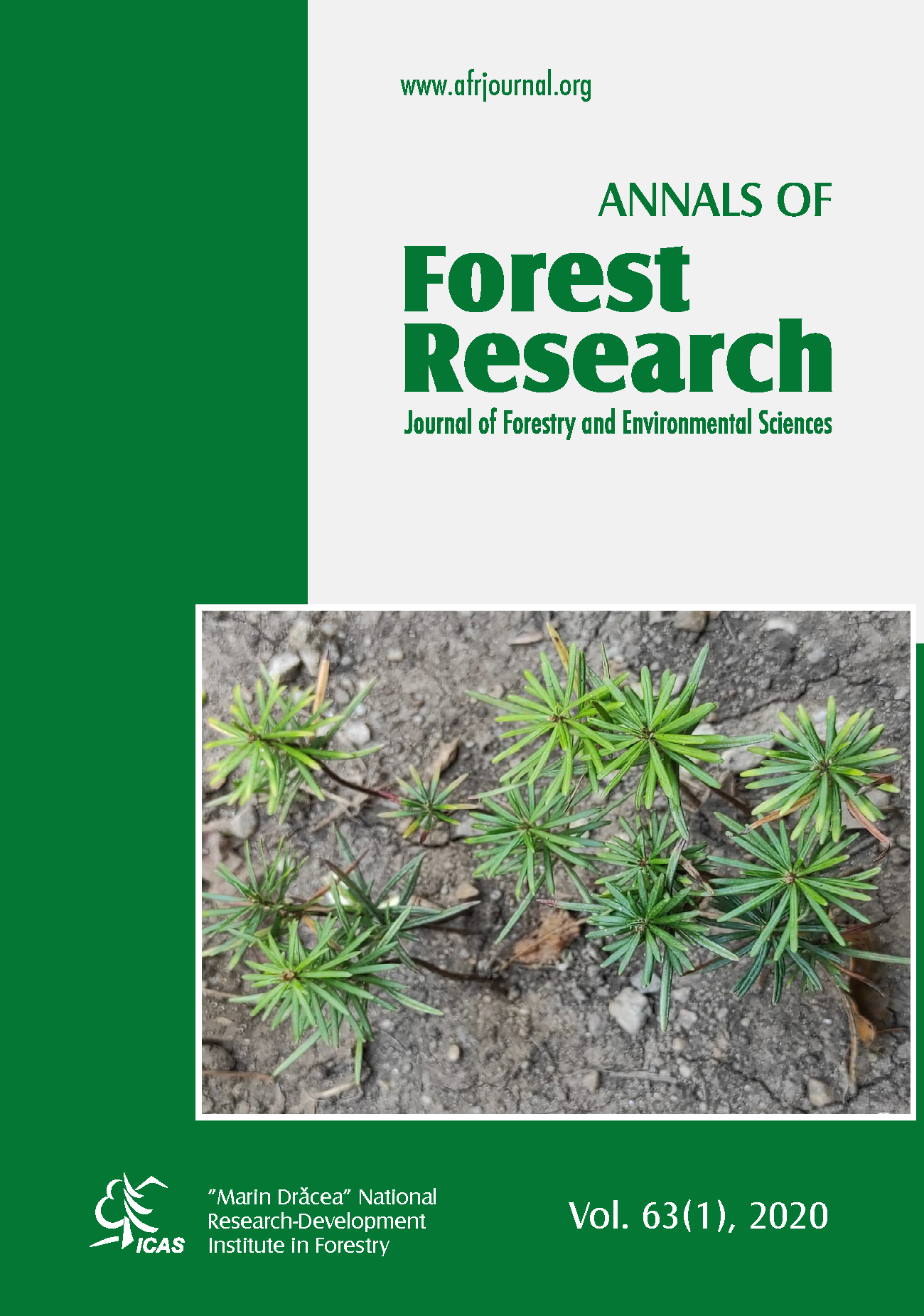A machine learning approach to model leaf area index in Eucalyptus plantations using high-resolution satellite imagery and airborne laser scanner data
DOI:
https://doi.org/10.15287/afr.2021.2073Abstract
As a forest structural parameter, leaf area index (LAI) is crucial for efficient intensive plantation management. Leaf area is responsible for the energy absorption needed for photosynthetic production and transpiration, both affecting growth. Currently, LAI can be estimated either by remote-sensing methods or ground-based methods. However, unlike ground-based methods, remote estimation provides a cost-effective and ecologically significant advance. The aim of our study was to evaluate whether machine learning algorithms can be used to quantify LAI, using either optical remote sensing or LiDAR metrics in Eucalyptus dunnii and Eucalyptus grandis stands. First, empirical relationships between LAI and remote-sensing data using LiDAR metrics and multispectral high-resolution satellite metrics, were assessed. Selected variables for LAI estimation were: forest canopy cover, laser penetration index, canopy relief ratio (from among the LiDAR data), the green normalized difference vegetation index, and normalized difference vegetation index (from among spectral vegetation indices). We compared the accuracy of three machine learning algorithms: artificial neural networks (ANN), random forest (RF) and support vector regression (SVR). The coefficient of determination ranged from 0.60, for ANN, to 0.84, for SVR. The SVR regression methods showed the best performance in terms of overall model accuracy and RMSE (0.60). The results show that the remote sensing data applied through machine learning algorithms provide an effective method to estimate LAI in eucalypt plantations. The methodology proposed is directly applicable for operational forest planning at the landscape level.
References
Alonso J., 2011. Modelación de procesos hidrológicos asociados a la forestación con Eucalyptus en el Uruguay. Facultad de Ingeniería, Universidad de la República.
Altmann A., Toloşi L., Sander O., Lengauer T., 2010. Permutation importance: A corrected feature importance measure. Bioinformatics, 26(10): 1340-1347. https://doi.org/10.1093/bioinformatics/btq134
Alvares C.A., Mattos E.M. de, Campoe O.C., Marrichi A.H.C., Stape J.L., 2015. Uso de sensoriamento remoto na estimativa do índice de área foliar em Eucalyptus. XVII Simpósio Brasileiro de Sensoriamento Remoto, pp. 6429-6436.
Ariza Salamanca A.J., Navarro-Cerrillo R.M., Bonet-García F.J., Pérez-Palazón M.J., Polo M.J., 2019. Integration of a Landsat time-series of NBR and hydrological modeling to assess Pinus pinaster Aiton. Forest Defoliation in South-Eastern Spain. Remote Sensing, 11(19): 2291. https://doi.org/10.3390/rs11192291
Castaño J.P., Giménez A., Ceroni M., Furest J., Aunchayna R., Bidegain M., 2011. Caracterización agroclimática del Uruguay 1980-2009. Serie Técnica INIA, 193: 33.
De Almeida A.Q., Ribeiro A., Delgado R.C., Rody Y.P., De Oliveira A.S., Leite F.P., 2015. Índice de área foliar de eucalyptus estimado por índices de vegetação utilizando imagens TM - landsat 5. Floresta e Ambiente, 22: 368-376. https://doi.org/10.1590/2179-8087.103414
De Godoy Goergen L.C., De Vargas Kilca R., Da Silva Narvaes I., Silva M.N., Silva E.A., Pereira R.S., Adami M., 2016. Distinção de espécies de eucalipto de diferentes idades por meio de imagens TM/Landsat 5. Pesquisa Agropecuaria Brasileira, 51: 53-60. https://doi.org/10.1590/S0100-204X2016000100007
Fassnacht F.E., Hartig F., Latifi H., Berger C., Hernández J., Corvalán P., Koch B., 2014. Importance of sample size, data type and prediction method for remote sensing-based estimations of aboveground forest biomass. Remote Sensing of Environment, 154: 102-114. https://doi.org/10.1016/j.rse.2014.07.028
Frazier A.E., Hemingway B.L., 2021. A technical review of planet smallsat data: Practical considerations for processing and using planetscope imagery. Remote Sensing, 13(19): 3930. https://doi.org/10.3390/rs13193930
Gitelson A.A., Merzlyak M.N., 1997. Remote estimation of chlorophyll content in higher plant leaves. International Journal of Remote Sensing, 18: 2691-2697.
Gitelson A.A., Merzlyak M.N., 1998. Remote sensing of chlorophyll concentration in higher plant leaves. Advances in Space Research, 22(5): 689-692. https://doi.org/10.1016/S0273-1177(97)01133-2
Gleason C.J., Im J., 2012. Forest biomass estimation from airborne LiDAR data using machine learning approaches. Remote Sensing of Environment, 125: 80-91. https://doi.org/10.1016/j.rse.2012.07.006
Hopkinson C., Chasmer L., 2009. Testing LiDAR models of fractional cover across multiple forest ecozones. Remote Sensing of Environment, 113(1): 275-288. https://doi.org/10.1016/j.rse.2008.09.012
Huete A., Van Leeuwen W., 1999. MODIS vegetation index (MOD13). Algorithm Theoretical Basis Document, 3(213): 295-309.
Ingram J.C., Dawson T.P., Whittaker R.J., 2005. Mapping tropical forest structure in southeastern Madagascar using remote sensing and artificial neural networks. Remote Sensing of Environment, 94(4): 491-507. https://doi.org/10.1016/j.rse.2004.12.001
Jain P., Coogan S.C.P., Subramanian S.G., Crowley M., Taylor S., Flannigan M.D., 2020. A review of machine learning applications in wildfire science and management. Environmental Reviews, 28(4): 478-505. https://doi.org/10.1139/er-2020-0019
Jensen J.L.R., Humes K.S., Vierling L.A., Hudak A.T., 2008. Discrete return lidar-based prediction of leaf area index in two conifer forests. Remote Sensing of Environment, 112(10): 3947-3957. https://doi.org/10.1016/j.rse.2008.07.001
Jonckheere I., Fleck S., Nackaerts K., Muys B., Coppin P., Weiss M., Baret F., 2004. Review of methods for in situ leaf area index determination Part I. Theories, sensors and hemispherical photography. Agricultural and Forest Meteorology, 121(1-2): 19-35. https://doi.org/10.1016/j.agrformet.2003.08.027
Jordan C.F., 1969. Derivation of leaf‐area index from quality of light on the forest floor. Ecology, 50(4): 663-666.
Lary D.J., Alavi A.H., Gandomi A.H., Walker A.L., 2016. Machine learning in geosciences and remote sensing. Geoscience Frontiers, 7(1): 3-10. https://doi.org/10.1016/j.gsf.2015.07.003
Le Maire G., Marsden C., Nouvellon Y., Stape J.L., Ponzoni F.J., 2012. Calibration of a species-specific spectral vegetation index for leaf area index (LAI) monitoring: Example with MODIS reflectance time-series on eucalyptus Plantations. Remote Sensing, 4(12): 3766-3780. https://doi.org/10.3390/rs4123766
Luo S., Wang C., Xi X., Nie S., Fan X., Chen H., Yang X., Peng D., Lin Y., Zhou G., 2019. Combining hyperspectral imagery and LiDAR pseudo-waveform for predicting crop LAI, canopy height and above-ground biomass. Ecological Indicators, 102: 801-812. https://doi.org/10.1016/j.ecolind.2019.03.011
Megown R.A., Webster M., Jacobs S., 1999. Using Landsat TM imagery to estimate LAI in a Eucalyptus plantation. 1-13.
Mesas-Carrascosa F.J., Castillejo-González I.L., De la Orden M.S., Porras A.G.F., 2012. Combining LiDAR intensity with aerial camera data to discriminate agricultural land uses. Computers and Electronics in Agriculture, 84: 36-46. https://doi.org/10.1016/j.compag.2012.02.020
Morsdorf F., Kötz B., Meier E., Itten K.I., Allgöwer B., 2006. Estimation of LAI and fractional cover from small footprint airborne laser scanning data based on gap fraction. Remote Sensing of Environment, 104(1): 50-61. https://doi.org/10.1016/j.rse.2006.04.019
Mountrakis G., Im J., Ogole C., 2011. Support vector machines in remote sensing: A review. ISPRS Journal of Photogrammetry and Remote Sensing, 66(3): 247-259. https://doi.org/10.1016/j.isprsjprs.2010.11.001
Pavithra B., Kalaivani K., Ulagapriya K., 1998. Remote sensing techniques for mangrove mapping. International Journal of Engineering and Advanced Technology, 8: 27-30.
Pearse G.D., Morgenroth J., Watt M.S., Dash J.P., 2017. Optimising prediction of forest leaf area index from discrete airborne lidar. Remote Sensing of Environment, 200: 220-239. https://doi.org/10.1016/j.rse.2017.08.002
Peduzzi A., Wynne R.H., Fox T.R., Nelson R.F., Thomas V.A., 2012. Estimating leaf area index in intensively managed pine plantations using airborne laser scanner data. Forest Ecology and Management, 270: 54-65. https://doi.org/10.1016/j.foreco.2011.12.048
Planet Labs, 2018. Precision Ag insights from frequent imaging smarter farming throughout the season. 22.
R Core Development Team, 2013. A language and environment for statistical computing. 1.
Rouse jr. J.W., Haas R.H., Schell J.A., Deering D.W., 1973. Monitoring the vernal advancement and retrogradation (green wave effect) of natural vegetation.
Scurlock J.M.O., Asner G.P., Gower S.T., 2001. Worldwide historical estimates of leaf area index, 1932–2000. ORNL/TM-2001/268, 34. https://doi.org/0RNL/TM-2001/268
Shen X., Cao L., Chen D., Sun Y., Wang G., Ruan H., 2018. Prediction of forest structural parameters using airborne full-waveform LiDAR and hyperspectral data in subtropical forests. Remote Sensing, 10(11): 1729. https://doi.org/10.3390/rs10111729
Solberg S., Næsset E., Hanssen K.H., Christiansen E., 2006. Mapping defoliation during a severe insect attack on Scots pine using airborne laser scanning. Remote Sensing of Environment, 102(3-4): 364-376. https://doi.org/10.1016/j.rse.2006.03.001
Staben G., Lucieer A., Scarth P., 2018. Modelling LiDAR derived tree canopy height from Landsat TM, ETM+ and OLI satellite imagery - A machine learning approach. International Journal of Applied Earth Observation and Geoinformation, 73: 666-681. https://doi.org/10.1016/j.jag.2018.08.013
Sumnall M., Peduzzi A., Fox T.R., Wynne R.H., Thomas V.A., Cook B., 2016a. Assessing the transferability of statistical predictive models for leaf area index between two airborne discrete return LiDAR sensor designs within multiple intensely managed Loblolly pine forest locations in the south-eastern USA. Remote Sensing of Environment, 176: 308-319. https://doi.org/10.1016/j.rse.2016.02.012
Sumnall M.J., Fox T.R., Wynne R.H., Blinn C., Thomas V.A., 2016b. Estimating leaf area index at multiple heights within the understorey component of Loblolly pine forests from airborne discrete-return lidar. International Journal of Remote Sensing, 37: 78-99. https://doi.org/10.1080/01431161.2015.1117683
Tavares Júnior I da S., Torres C.M.M.E., Leite H.G., Castro N.L.M. de, Soares C.P.B., Castro R.V.O., Farias A.A., 2020. Machine learning: Modeling increment in diameter of individual trees on Atlantic Forest fragments. Ecological Indicators, 117: 106685. https://doi.org/10.1016/j.ecolind.2020.106685
Tesfamichael S.G., van Aardt J., Roberts W., Ahmed F., 2018. Retrieval of narrow-range LAI of at multiple lidar point densities: Application on Eucalyptus grandis plantation. International Journal of Applied Earth Observation and Geoinformation, 70: 93-104. https://doi.org/10.1016/j.jag.2018.04.014
Tseng Y.H., Lin L.P., Wang C.K., 2016. Mapping CHM and LAI for heterogeneous forests using airborne full-waveform LiDAR data. Terrestrial, Atmospheric and Oceanic Sciences, 27: 537-548. https://doi.org/10.3319/TAO.2016.01.29.04(ISRS)
Watson D.J., 1947. Comparative physiological studies on the growth of field crops: I. Variation in net assimilation rate and leaf area between species and varieties, and within and between years. Annals of Botany, 11: 41-76. https://doi.org/10.1093/oxfordjournals.aob.a083148
Weiss M., Baret F., Smith G.J., Jonckheere I., Coppin P., 2004. Review of methods for in situ leaf area index (LAI) determination Part II. Estimation of LAI, errors and sampling. Agricultural and Forest Meteorology, 121: 37-53. https://doi.org/10.1016/j.agrformet.2003.08.001
Whitehead D., Beadle C.L., 2004. Physiological regulation of productivity and water use in Eucalyptus: A review. Forest Ecology and Management, 193: 113-140. https://doi.org/10.1016/j.foreco.2004.01.026
Xue J., Su B., 2017. Significant remote sensing vegetation indices: A review of developments and applications. Journal of Sensors, 2017. https://doi.org/10.1155/2017/1353691
Yan G., Hu R., Luo J., Weiss M., Jiang H., Mu X., Xie D., Zhang W., 2019. Review of indirect optical measurements of leaf area index: Recent advances, challenges, and perspectives. Agricultural and Forest Meteorology, 265: 390-411. https://doi.org/10.1016/j.agrformet.2018.11.033
Yuan H., Yang G., Li C., Wang Y., Liu J., Yu H., Feng H., Xu B., Zhao X., Yang X., 2017. Retrieving soybean leaf area index from unmanned aerial vehicle hyperspectral remote sensing: Analysis of RF, ANN, and SVM regression models. Remote Sensing, 9. https://doi.org/10.3390/rs9040309
Zaletnyik P., Laky S., Toth C., 2010. LIDAR waveform classification using self-organizing map. American Society for Photogrammetry and Remote Sensing Annual Conference 2010: Opportunities for Emerging Geospatial Technologies, 2: 1055-1066.
Zhao K., Popescu S., 2009. Lidar-based mapping of leaf area index and its use for validating GLOBCARBON satellite LAI product in a temperate forest of the southern USA. Remote Sensing of Environment, 113: 1628-1645. https://doi.org/10.1016/J.RSE.2009.03.006
Zhou H., Wang C., Zhang G., Xue H., Wang J., Wan H., 2020. Generating a spatio-temporal complete 30 m leaf area index from field and remote sensing data. Remote Sensing, 12: 2394. https://doi.org/10.3390/rs12152394
Zhou Y., Qiu F., 2015. Fusion of high spatial resolution WorldView-2 imagery and LiDAR pseudo-waveform for object-based image analysis. ISPRS Journal of Photogrammetry and Remote Sensing, 101: 221-232. https://doi.org/10.1016/j.isprsjprs.2014.12.013
Downloads
Published
Issue
Section
License
All the papers published in Annals of Forest Research are available under an open access policy (Gratis Gold Open Access Licence), which guaranty the free (of taxes) and unlimited access, for anyone, to entire content of the all published articles. The users are free to "read, copy, distribute, print, search or refers to the full text of these articles", as long they mention the source.
The other materials (texts, images, graphical elements presented on the Website) are protected by copyright.
The journal exerts a permanent quality check, based on an established protocol for publishing the manuscripts. The potential article to be published are evaluated (peer-review) by members of the Editorial Board or other collaborators with competences on the paper topics. The publishing of manuscript is free of charge, all the costs being supported by Forest Research and Management Institute.
More details about Open Access:
Wikipedia: http://en.wikipedia.org/wiki/Open_access






